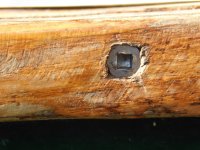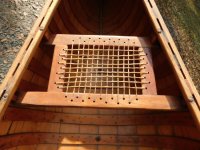I would like to pick the brains of those in this forum and see if you know who may have made this canoe. This is my first wood canoe since I started paddling over four decades ago, so my knowledge is limited in this area. I hope to learn more about wood and canvas as I progress.
I just pick up what was originally a wood and canvas canoe, though it has been subjected to the “heresy” of being covered in fiberglass. There are no maker’s marks except for the number 7970 cut and apparently burned into the bow stem. The fiberglass shows no delamination, voids or hollow sounding spots. The hull looks good to my eyes with no visible rot, cracks or patches. The gunwales and thwarts look to be in serviceable shape, needing a good sanding and varnishing. The decks are heart shaped and also in good solid condition. The seats are in nice shape and appear to be rawhide or perhaps babiche. The deck ring and screws have a fair bit of corrosion and the gunwale and keel screws take a square bit, though some are rounded out. The stem bands look to be in nice condition. The keel is bare wood, and will have to be treated (varnished?) before use.
The specs that I have measured are as follows:
Length: 16’2”
Width: 35 ½” across the hull; 36 ¾” outside gunwale to outside gunwale
Depth: 17” bow, 13 1/2” amidships, 17” stern
Keel: 1 ¼” wide by 1” deep
Ribs: 2"wide in center and 1 3/4" nearing ends
Rocker: not sure proper measuring point, but looks to be around 2” at an approximate 3” waterline
Weight (on a bathroom scale) 68.0 lbs.
The backstory that I have on this canoe is that it was purchased around fifteen years ago in upstate New York from an “elderly gentleman in his eighties” who had purchased the canoe new over forty years earlier. According to the teller it was made by “Indians”. The gentleman replaced the canvas with fiberglass sometime after the original canvas wore out. It had been a family canoe and stored indoors by the second owners who sold it to me during downsizing.
With the heart shaped decks and the story of “being made by Indians”, I wonder if it may be one of the Huron canoe builds. I have found nothing about the four-digit number stamped on the stem though.
I have a lot to learn on wooden canoes, and any information that you can share will be greatly appreciated.
I just pick up what was originally a wood and canvas canoe, though it has been subjected to the “heresy” of being covered in fiberglass. There are no maker’s marks except for the number 7970 cut and apparently burned into the bow stem. The fiberglass shows no delamination, voids or hollow sounding spots. The hull looks good to my eyes with no visible rot, cracks or patches. The gunwales and thwarts look to be in serviceable shape, needing a good sanding and varnishing. The decks are heart shaped and also in good solid condition. The seats are in nice shape and appear to be rawhide or perhaps babiche. The deck ring and screws have a fair bit of corrosion and the gunwale and keel screws take a square bit, though some are rounded out. The stem bands look to be in nice condition. The keel is bare wood, and will have to be treated (varnished?) before use.
The specs that I have measured are as follows:
Length: 16’2”
Width: 35 ½” across the hull; 36 ¾” outside gunwale to outside gunwale
Depth: 17” bow, 13 1/2” amidships, 17” stern
Keel: 1 ¼” wide by 1” deep
Ribs: 2"wide in center and 1 3/4" nearing ends
Rocker: not sure proper measuring point, but looks to be around 2” at an approximate 3” waterline
Weight (on a bathroom scale) 68.0 lbs.
The backstory that I have on this canoe is that it was purchased around fifteen years ago in upstate New York from an “elderly gentleman in his eighties” who had purchased the canoe new over forty years earlier. According to the teller it was made by “Indians”. The gentleman replaced the canvas with fiberglass sometime after the original canvas wore out. It had been a family canoe and stored indoors by the second owners who sold it to me during downsizing.
With the heart shaped decks and the story of “being made by Indians”, I wonder if it may be one of the Huron canoe builds. I have found nothing about the four-digit number stamped on the stem though.
I have a lot to learn on wooden canoes, and any information that you can share will be greatly appreciated.
Attachments
-
 DSCN0953.JPG213.3 KB · Views: 43
DSCN0953.JPG213.3 KB · Views: 43 -
 DSCN0980.JPG146.2 KB · Views: 40
DSCN0980.JPG146.2 KB · Views: 40 -
 DSCN0972.JPG125 KB · Views: 42
DSCN0972.JPG125 KB · Views: 42 -
 DSCN0969.JPG129.3 KB · Views: 42
DSCN0969.JPG129.3 KB · Views: 42 -
 DSCN0974.JPG132.5 KB · Views: 43
DSCN0974.JPG132.5 KB · Views: 43 -
 DSCN0988.JPG209.3 KB · Views: 42
DSCN0988.JPG209.3 KB · Views: 42 -
 DSCN0971.JPG191.1 KB · Views: 43
DSCN0971.JPG191.1 KB · Views: 43 -
 DSCN0964.JPG94.4 KB · Views: 39
DSCN0964.JPG94.4 KB · Views: 39 -
 DSCN0962.JPG168.1 KB · Views: 40
DSCN0962.JPG168.1 KB · Views: 40 -
 DSCN0961.JPG148.4 KB · Views: 41
DSCN0961.JPG148.4 KB · Views: 41 -
 DSCN0956.JPG150.7 KB · Views: 41
DSCN0956.JPG150.7 KB · Views: 41 -
 DSCN0954.JPG191.1 KB · Views: 43
DSCN0954.JPG191.1 KB · Views: 43 -
 DSCN0959.JPG133.8 KB · Views: 40
DSCN0959.JPG133.8 KB · Views: 40 -
 DSCN0990.JPG77.8 KB · Views: 37
DSCN0990.JPG77.8 KB · Views: 37 -
 DSCN0988.JPG209.3 KB · Views: 41
DSCN0988.JPG209.3 KB · Views: 41
Last edited:


